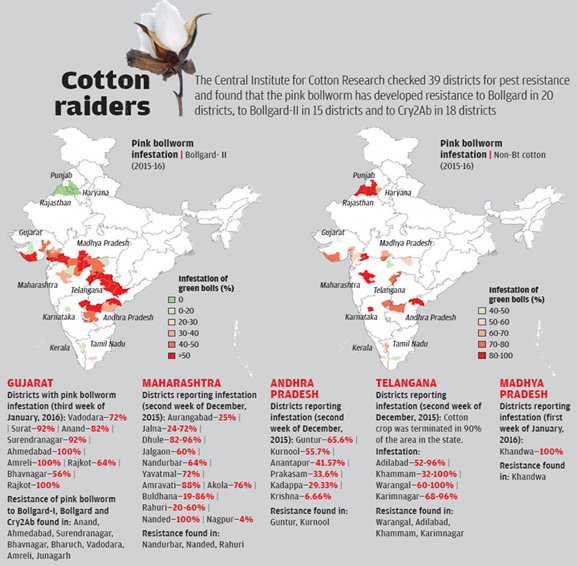

Context:
According to a recent study, the Pink Bollworm in India has grown to become worse than the American bollworm and affecting significantly to cotton farmers.
- This is the fourth story in a series about pink bollworm attacks on Bt cotton in the North Zone, comprising Punjab, Haryana and Rajasthan.
Bt Cotton introduction in India:
- Bt cotton was introduced to India in 2002 after its success in the United States and Australia in 1996.
- Before that, the American bollworm had become the biggest threat to cotton crops as it had developed resistance to synthetic pyrethroids, organophosphorus and carbamates (group of insecticides).
- From 1985-2002, it caused heavy economic losses to farmers in all 11 cotton-growing states of India.
|
What is Bt Cotton?
|
Pests getting resistant to Bt Cotton:
- Indian farmers have faced consistent losses of Bt cotton crops due to pink bollworm attacks since the mid-2000s, when scientists found that the insect had become resistant to the genetically modified variety of cotton.
- Bacillus thuringiensis (Bt) cotton, or Bollgard-I, was introduced to protect the crop against all three species of bollworms (American, spotted and pink bollworms) as it was encoded with Cry1Ac toxin.
- In 2005, scientists with the Indian Agricultural Research Institute started monitoring if pests were growing resistant to Bt cotton. A year later, Bt cotton was encoded with Cry2Ab gene for improved resistance against the American bollworm.
- But in 2008, researchers found unusual survival of pink bollworm in Amreli district of Gujarat, indicative of the pest’s resistance to Bt cotton. Later, through scientific study, in 2009-10, scientists confirmed pink bollworm’s resistance to Cry1Ac gene in four districts of Gujarat.
- In 2017-18, widespread pink bollworm infestation was reported in Maharashtra and the southern states.
- Then in 2021-22, a pink bollworm outbreak was reported in Punjab and Haryana.
- By 2023, resistant populations of pink bollworm to Bt cotton were established in the North Zone including north Rajasthan districts.

|
About Pink Bollworm:
|
Way Forward:
- In recent years, pink bollworm infestations have posed a significant threat to cotton cultivation in various regions, particularly in India.
- Farmers have faced challenges in managing these pests due to their ability to develop resistance to conventional pesticides.
- To combat the pink bollworm, integrated pest management strategies, including the use of genetically modified Bt cotton varieties and the deployment of sterile insect release programs, have been implemented.
- These efforts aim to reduce the impact of pink bollworm infestations and safeguard cotton production, which is crucial for the textile industry and livelihoods in affected regions.


